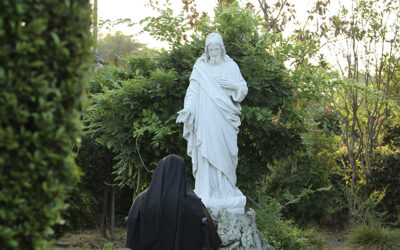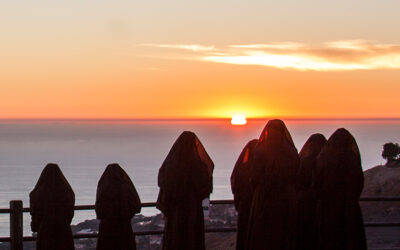There is nothing on this earth more to be prized than true friendship.
-Saint Thomas Aquinas
Picture in your imagination a recreation room in a Carmelite monastery of nuns or in a Carmelite Friary!
A young Carmelite nun spots a pair of castanets on a shelf, rushes over to retrieve them, begins to sing a Spanish song and dances with stomping feet around the room before the other nuns.
It is Christmas and a statue of the Christ Child is displayed prominently in the Friars recreation room. A young friar picks up the Christ Child, cradles it in his arms and dances joyously around the room before the other friars.
This is 16th century Spain. Perhaps we would not find it difficult to imagine the vivacious, charming Teresa of Avila entertaining her Sisters this way, but might we not be somewhat taken aback at the quiet, reserved Friar, John of the Cross, who is known for his “Nada, nada” twirling about in a spontaneous joyous dance?
These two, although years apart in age and in their lived experience of religious life first met when Teresa, beginning the foundation of her second reformed Carmel, was 52 years of age and John newly ordained as a priest was 25. At the time of their first conversation John was considering leaving the Carmelite Order for a more prayerful and secluded life as a Carthusian monk. Teresa, dissatisfied with the quality of her religious life after living several years at the Incarnation Convent in Avila, had begun her reform to establish houses closer to the original spirit of Carmel. Having permission to also erect a reformed priory she needed a male counterpart to begin the foundation. This would require a like-minded person, one who shared a common vision. Thus out of this need grew a deep and lasting friendship.
Teresa speaks of such a relationship when she writes in one of her letters, “What a wonderful thing it is for two souls to understand each other, for they neither lack something to say, nor grow tired.”
In such a well-balanced friendship of spiritual depth the human need for companionship and support is afforded. Since no one person possesses all gifts each must have gifts to offer the other and the capacity to receive from the other. Thus each makes up to some extent what is lacking in oneself. This source of mutual help must be rooted in one’s love of God. Thomas Merton expressed this well when he said, “We will see that we are human, like everyone else, that we all have weaknesses and deficiencies, and that these limitations of ours play a most important part in all our lives. It is because of them that we need others and others need us. We are not all weak in the same spots, and so we supplement and complete one another, each one making up in himself for the lack in another.”
— No Man Is an Island
John recognized in Teresa’s reform what he had so ardently been seeking and acknowledged her leadership and guidance. Teresa appreciated in this new acquaintance the richness of his deep interior life and soon selected him as her spiritual director and later requested him as the confessor for the Incarnation Convent. Their likenesses advanced them toward the same goal while their differences enhanced the spirit that would permeate the reform.
Father Thomas Dubay, S.M. in Fire Within comments that for Teresa “a person’s degree of immersion in God was the degree of her love for that person.” No wonder she was so delighted to have John of the Cross as a companion in the reform!
Although they shared some secondary traits of likeness, such as keen intelligence, common sense, determination, and courage, both saints were also misjudged and misunderstood even by the members of their own communities. They both experienced opposition to their efforts at reform.
Their similarities went beyond this in their ardent desire to embrace the primitive Rule of Carmel, their longing for a deeper prayer life, their practice of poverty in the simplicity of their lives, the compassion evident in their love for others, active reformers and yet mystics.
Both were among the acclaimed writers of the spiritual life and able to articulate well their own mystical experiences; both became saints and doctors of the Church.
Not everything was similar; there were definite differences between them but each of these dissimilarities brought a richness in their approach to living out their Carmelite charism and to the decisions they made as the reform took shape.
John was born into an impoverished family and was able to continue his education due to the charity and compassion of others. Even in the reform movement being in need was a normal experience for him. Teresa came from a fairly well-to-do family and was used to good living. Thus when she, as a religious, was enjoying a meal of partridge which was looked upon with some concern, she said, “When I fast, I fast; and when I eat partridge, I eat partridge”. Both saints came to their understanding of poverty from different perspectives.
Teresa was animated, chatty and witty, a definite people person but she was also a no-nonsense person. She was a born leader and took center stage. Her manner of relating to others, whether they be circles of several persons or of individuals would look quite different from John’s interactions. His manner was more reserved, gentle and unnoticed, but when called upon he was quite capable of exercising leadership and good management.
“For as the rain and the snow come down from heaven and do not return there but water the earth, making it bring forth and sprout, giving seed to the sower and bread to the eater, …” (Isaiah 55:10). Rain and snow are the gifts that God pours down upon the earth to provide bread for His people. In the Lord’s Prayer we ask for our “daily bread”. But the daily bread is already there in the many gifts He has bestowed on each individual. We have but to distribute our bread to others. We have gifts in common with others but we also are given many gifts different from those of others which we are called upon to share with them.
Teresa and John shared their gifts with each other and with many others. Thus a great crescendo arose which continues to this day in the Carmelite Reform. The test of a holy friendship, therefore, is our desire for the other to be totally immersed in God.
“There is nothing on this earth more to be prized than true friendship.” (St. Thomas Aquinas)




